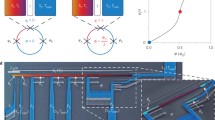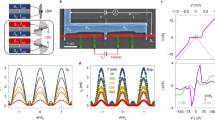Abstract
We describe here the first experimental realization of a heat interferometer, thermal counterpart of the well-known superconducting quantum interference device. These findings demonstrate, in the first place, the existence of phase-dependent heat transport in Josephson-based superconducting circuits and, in the second place, open the way to novel ways of mastering heat at the nanoscale. Combining the use of external magnetic fields for phase biasing and different Josephson junction architectures we show here that a number of heat interference patterns can be obtained. The experimental realization of these architectures, besides being relevant from a fundamental physics point of view, might find important technological application as building blocks of phase-coherent quantum thermal circuits. In particular, the performance of two different heat rectifying devices is analyzed.












Similar content being viewed by others
Notes
Source, drain and S\(_3\) junctions normal-state resistances are \(R_\mathrm{src}\simeq 1.5\) k\(\Omega \), \(R_\mathrm{dr}\simeq 1\) k\(\Omega \) and \(R_\mathrm{p}\sim 0.55\) k\(\Omega \), respectively, whereas the resistance of each SQUID junction is \(R_\mathrm{J}\simeq 1.3\) k\(\Omega \). The ring area is \(\sim \)19.6 \(\upmu \)m\(^2\). Finally, NIS thermometers exhibit \(\sim \)25 k\(\Omega \) normal-state resistance each.
\(\dot{Q}_{S_3}=\dot{Q}_{tot}(T_\mathrm{hot},T_\mathrm{cold},0)\) (see Eq. (1)) substituting \(R_\mathrm{J}\) for \(R_\mathrm{p}\), \(\mathcal {N}_2 (\varepsilon ,T_\mathrm{cold})\) for \(\mathcal {N}_3 (\varepsilon ,T_\mathrm{cold})=\mathcal {N}_2 (\varepsilon ,T_\mathrm{cold})\) and \(\mathcal {M}_2 (\varepsilon ,T_\mathrm{cold})\) for \(\mathcal {M}_3 (\varepsilon ,T_\mathrm{cold})=\mathcal {M}_2 (\varepsilon ,T_\mathrm{cold})\). Furthermore, \(\dot{Q}_\mathrm{src}\) can be obtained from Eq. (2) by doing \(\dot{Q}_\mathrm{src}=\dot{Q}_{qp}(T_\mathrm{hot}, T_\mathrm{src})\) with \(\mathcal {N}_2=1\) and substituting \(R_\mathrm{J}\) for \(R_\mathrm{src}\), \(\dot{Q}_\mathrm{dr}\) can be also obtained from Eq. (2) by setting \(\dot{Q}_\mathrm{dr}=-\dot{Q}_{qp}(T_\mathrm{hot}, T_\mathrm{dr})\) with \(\mathcal {N}_2=1\) and substituting \(R_\mathrm{J}\) for \(R_\mathrm{dr}\). For the normal metal \(\dot{Q}_\mathrm{e-ph,dr}=\Sigma _\mathrm{dr} \mathcal {V}_\mathrm{dr}(T_\mathrm{dr}^5-T_\mathrm{bath}^5)\), where \(\Sigma _\mathrm{dr} \simeq 3\times 10^9\) WK\(^{-5}\)m\(^{-3}\) is the electron-phonon coupling constant for Cu [13], and \(\mathcal {V}_\mathrm{dr}\simeq 2\times 10^{-20}\) m\(^{3}\) is drain volume.
As a set of parameters representative for a realistic microstructure we choose \(R_\mathrm{src}=R_\mathrm{dr}=2\) k\(\Omega \), \(R_\mathrm{J}=500\) \(\Omega \), \(\mathcal {V}_\mathrm{dr}=10^{-20}\) m\(^{-3}\), \(\Sigma _\mathrm{dr}=3\times 10^9\) WK\(^{-5}\,\)m\(^{-3}\) (typical of Cu) [13], \(\mathcal {V}_\mathrm{S_1}=10^{-18}\) m\(^{-3}\), \(\Sigma _\mathrm{S_1}=3\times 10^8\) WK\(^{-5}\) m\(^{-3}\) and \(\Delta _1(0)=\Delta _2(0)=200\,\upmu \)eV, the last two parameters typical of aluminum (Al) [13].
When this condition is no longer satisfied an effective thickness (\(\tilde{t}_H\)) must be used, where \(\tilde{t}_H=\lambda _1\mathrm tanh (T_\mathrm{hot}/2\lambda _1)+\lambda _2\mathrm tanh (T_\mathrm{hot}/2\lambda _2)+d\) [34].
Calculations are performed using the same fabrication parameters of 5.2, i.e., \(R_\mathrm{src}=R_\mathrm{dr}=2\) k\(\Omega \), \(R_\mathrm{J}=500\) \(\Omega \), \(\mathcal {V}_{dr}=10^{-20}\) m\(^{-3}\), \(\Sigma _{dr}=3\times 10^9\) WK\(^{-5}\)m\(^{-3}\), \(\mathcal {V}_{S_1}=10^{-18}\) m\(^{-3}\), \(\Sigma _{S_1}=3\times 10^8\) WK\(^{-5}\)m\(^{-3}\) and \(\Delta _1(0)=\Delta _2(0)=200\,\upmu \)eV.
\(\dot{Q}_\mathrm{dr}=\frac{2}{e^2 R_\mathrm{dr}}\int ^{\infty }_{0} d\varepsilon \varepsilon [f(\varepsilon ,T_\mathrm{dr}^+)-f(\varepsilon ,T_\mathrm{cold})]\) [13]. \(T_\mathrm{src }^-\) can be obtained in a similar way for the reverse configuration by simply exchanging the roles of \(\dot{Q}_\mathrm{src} \Leftrightarrow \dot{Q}_\mathrm{dr} \), \(\dot{Q}_\mathrm{e-ph,S} \Leftrightarrow \dot{Q}_\mathrm{e-ph,N}\), \(\dot{Q}_{+} \Leftrightarrow \dot{Q}_{-}\) and \(\dot{Q}_\mathrm{e-ph,dr} \Leftrightarrow \dot{Q}_\mathrm{e-ph,src}\). As representative parameters we set \(\mathcal {V}_\mathrm{src}=\mathcal {V}_\mathrm{dr}=\mathcal {V}_\mathrm{N}=\mathcal {V}_\mathrm{S} = 10^{-20}\) m\(^{3}\). We choose Cu for which \(\Sigma _\mathrm{src}=\Sigma _\mathrm{dr}=\Sigma _\mathrm{N}\simeq 3 \times 10^9\) WK\(^{-5}\) m\(^{-3}\) [13] and Al \(\Sigma _\mathrm{S} \simeq 0.3 \times 10^9\) WK\(^{-5}\)m\(^{-3}\) [13].
For these calculations we have assumed a lifetime broadening \(\gamma =10^{-5}\), which accounts well for the subgap leakage in realistic SIS junctions. \(\mathcal {R}\) is reduced to \(\sim 650\,\%\) when considering \(\gamma =10^{-4}\) and down to \(\sim 500\,\%\) for \(\gamma =10^{-3}\).
The thermal model is very similar to that used in the previous section but changing \(\dot{Q}_\mathrm{e-ph,N}\) by \(\dot{Q}_\mathrm{e-ph,S_2}\) as given in Eq. 4 and setting \(\dot{Q}_\mathrm{dr}=-\dot{Q}_{qp}(T_\mathrm{cold}, T_\mathrm{dr}^{+})\) (Eq. (2)) with \(\mathcal {N}_2=1\) and substituting \(R_\mathrm{J}\) for \(R_\mathrm{dr}\) (see Fig. 12b). As representative parameters we set again \(\mathcal {V}_\mathrm{src}=\mathcal {V}_\mathrm{dr}=\mathcal {V}_\mathrm{S_1}=\mathcal {V}_\mathrm{S_2} = 10^{-20}\) m\(^{3}\), \(R_\mathrm{J} = 5\) k\(\Omega \) and \(R_\mathrm{src} =R_\mathrm{dr}= 1\) k\(\Omega \). We use Cu for which \(\Sigma _\mathrm{src}=\Sigma _\mathrm{dr}\simeq 3 \times 10^9\) WK\(^{-5}\)m\(^{-3}\) [13] and Al and Mn-doped Al with \(\Sigma _\mathrm{S} \simeq 0.3 \times 10^9\) WK\(^{-5}\)m\(^{-3}\) [13]. For these materials we set \(\Delta _2=1.4\) K and \(\delta =0.75\).
References
B.D. Josephson, Phys. Lett. 1, 251 (1962)
K. Maki, A. Griffin, Phys. Rev. Lett. 15, 921 (1965)
F. Giazotto, M.J. Martínez-Pérez, Appl. Phys. Lett. 101, 102601 (2012)
F. Giazotto, M.J. Martínez-Pérez, Nature 492, 401 (2012)
R.W. Simmonds, Nature 492, 358 (2012)
A.G. Aronov, and Yu.M. Gal’perin, Pis’ma Zh. Eksp. Teor Fiz. 19, 281, (1974) [ JETP Lett. 19, 166, (1974)].
G.I. Panaitov, V.V. Ryazanov, A.V. Ustinov, V.V. Schmidt, Phys. Lett. A 100, 301 (1984)
V.V. Shmidt, Pis’ma Zh. Eksp. Teor Fiz. 33, 104, (1981) [ JETP Lett. 33, 98, (1981)].
V.L. Ginzburg, Zh. Eksp. Teor. Fiz. 14, 177, (1944) [ Sov. Phys. JETP 8, 148, (1944)].
M.V. Kartsovnik, V.V. Ryazanov, and V.V. Shmidt, Pis’ma Zh. Eksp. Teor Fiz. 33, 373, (1981) [ JETP Lett. 33, 356, (1981)].
V.V. Ryazanov, V.V. Schmidt, Solid State Commun. 42, 733 (1982)
G.D. Guttman, B. Nathanson, E. Ben-Jacob, D.J. Bergman, Phys. Rev. B 55, 12691 (1997)
F. Giazotto, T.T. Heikkilä, A. Luukanen, A.M. Savin, J.P. Pekola, Rev. Mod. Phys. 78, 217 (2006)
D. Golubev, T. Faivre, J.P. Pekola, Phys. Rev. B 87, 094522 (2013)
G.D. Guttman, B. Nathanson, E. Ben-Jacob, D.J. Bergman, Phys. Rev. B 55, 3849 (1997)
G.D. Guttman, E. Ben-Jacob, D.J. Bergman, Phys. Rev. B 57, 2717 (1998)
E. Zhao, T. Löfwander, J.A. Sauls, Phys. Rev. Lett. 91, 077003 (2003)
E. Zhao, T. Löfwander, J.A. Sauls, Phys. Rev. B 69, 134503 (2004)
A. Barone, G. Paternó, Physics and Applications of the Josephson Effect (Wiley, New York, 1982)
F.C. Wellstood, C. Urbina, J. Clarke, Phys. Rev. B 49, 5942 (1994)
A.V. Timofeev, C.P. García, N.B. Kopnin, A.M. Savin, M. Meschke, F. Giazotto, J.P. Pekola, Phys. Rev. Lett. 102, 017003 (2009)
M. Tinkham, Introduction to Superconductivity, 2nd edn. (McGraw-Hill, New York, 1996)
M. Bo, T. Zhong-Kui, M. Shu-Chao, D. Yuan-Dong, W. Fu-Ren, Chin. Phys. 13, 1226 (2004)
J. Clarke, A.I. Braginski (eds.), The SQUID Handbook (Wiley-VCH, Weinheim, 2004)
M. Nahum, J.M. Martinis, Appl. Phys. Lett. 63, 3075 (1993)
M.L. Roukes, M.R. Freeman, R.S. Germain, R.C. Richardson, M.B. Ketchen, Phys. Rev. Lett. 55, 422 (1985)
D.R. Schmidt, R.J. Schoelkopf, A.N. Cleland, Phys. Rev. Lett. 93, 045901 (2004)
M. Meschke, W. Guichard, J.P. Pekola, Nature 444, 187 (2006)
A.V. Timofeev, M. Helle, M. Meschke, M. Möttönen, J.P. Pekola, Phys. Rev. Lett. 102, 200801 (2009)
M.J. Martínez-Pérez, F. Giazotto, Appl. Phys. Lett. 102, 092602 (2013)
A. Kemppinen, A.J. Manninen, M. Möttönen, J.J. Vartiainen, J.T. Peltonen, J.P. Pekola, Appl. Phys. Lett. 92, 052110 (2008)
F. Giazotto, M.J. Martínez-Pérez, P. Solinas, Phys. Rev. B 88, 094506 (2013)
J.M. Rowell, Phys. Rev. Lett. 11, 200 (1963)
M. Weihnacht, Phys. Status Solidi 32, K169 (1969)
J.S. Langer, V. Ambegaokar, Phys. Rev. 164, 498 (1967)
A.D. Zaikin, D.S. Golubev, A. van Otterlo, G.T. Zimanyi, Phys. Rev. Lett. 78, 1552 (1997)
O.V. Astafiev, L.B. Ioffe, S. Kafanov, Y.A. Pashkin, K.Y. Arutyunov, D. Shahar, O. Cohen, J.S. Tsai, Nature 484, 355 (2012)
N. Martucciello, R. Monaco, Phys. Rev. B 53, 3471 (1996)
C. Nappi, Phys. Rev. B 55, 82 (1997)
M.J. Martínez-Pérez, F. Giazotto, Appl. Phys. Lett. 102, 182602 (2013)
N.A. Roberts, D.G. Walker, Int. J. Therm. Sci. 50, 648 (2011)
G. O’Neil, D. Schmidt, N.A. Miller, J.N. Ullom, A. Williams, G.B. Arnold, S.T. Ruggiero, Phys. Rev. Lett. 100, 056804 (2008)
J. Ren, P. Hänggi, B. Li, Phys. Rev. Lett. 104, 170601 (2010)
M. J. Martínez-Pérez and F. Giazotto. ArXiv:1310.0639 (2013).
Acknowledgments
The FP7 program No. 228464 MICROKELVIN, the Italian Ministry of Defense through the PNRM project TERASUPER, the Marie Curie Initial Training Action (ITN) Q-NET 264034 and FIRB—Futuro in Ricerca 2012 under Grant No. RBFR1236VV HybridNanoDev. are acknowledged for partial financial support.
Author information
Authors and Affiliations
Corresponding author
Rights and permissions
About this article
Cite this article
Martínez-Pérez, M.J., Solinas, P. & Giazotto, F. Coherent Caloritronics in Josephson-Based Nanocircuits. J Low Temp Phys 175, 813–837 (2014). https://doi.org/10.1007/s10909-014-1132-6
Received:
Accepted:
Published:
Issue Date:
DOI: https://doi.org/10.1007/s10909-014-1132-6




